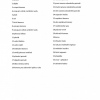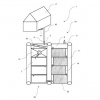Floating sewage treatment plant
Technology description
| The name of the technology: | Floating sewage treatment plant |
|---|---|
| Challenge: | The basic motivation for this solution is the fact that one person produces an average of 150-200 l of wastewater per day. In secluded places and in case of lack of space, it is not possible to clean waste water. Typically, this is a problem for holiday homes in the proximity of waters (rivers, lakes, sea coasts, etc.). The solution can be a floating sewage treatment plant according to the proposed invention. |
| Description: |
Wastewater treatment plant is a solution that cleans waste water without the presence of energy inputs, without the need to take up land or major construction work, and which does not limit the further use of existing infrastructure around the building to which the facility is connected. The device includes an inlet chamber with an inlet of polluted water, a sand trap and a fat trap, at least one cleaning chamber and an output chamber with an output for the drainage of purified water. The essence of the invention is that the entrance chamber, sand trap and fat trap, at least one cleaning chamber and the output chamber form integral components of a floating body equipped with floats to keep the body on the surface of the water tank. At least one wetland chamber with an artificial floating wetland is arranged between the cleaning chamber and the exit chamber. The equipment also includes a supply line of contaminated water treated at one end for connection to the waste pipe of the building and at the other end for connection to the entrance chamber. According to this invention, the device is the most technologically simple and cost-effective solution for the treatment of a small amount of occasional wastewater by combining the use of various standard technologies of mechanical and biological wastewater treatment and cleaning using an artificial floating wetland. A floating sewage treatment plant can be placed off the coast of stagnant water. It is especially suitable for recreational facilities. Installation is carried out without major construction work. It can work passively without the need for energy. It is possible to use the treatment plant secondaryly as a pier. Another possibility of use is obtaining biogas for cooking/heating. There are also possibilities of intensification, such as placing aeration under the roots of a floating wetland, use of photovoltaics, overlapping of the floating wetland with a foil, the possibility of watering vegetables on rafts, by the sea picking cleaned "fresh" water into floating bags for watering and other uses. |
| Commercial opportunity: |
Wastewater treatment equipment according to this invention can be used mainly in remote areas that are poorly accessible for the construction of conventional sewage treatment plants and are located near stagnant waters, i.e. near lakes, sea coasts, calm river flows, dam or pond. This facility is especially suitable for smaller seasonally used recreational buildings, or even houses that produce a smaller amount of wastewater. In these places, due to remoteness and demanding terrain, it is often not possible to build classic wastewater treatment plants, or to store wastewater or remotely transport it. The device can be operated without the need for electricity, only gravitationally. The device also serves secondaryly as a pier for smaller ships. Its application can be seen not only in the Czech Republic, but especially in foreign countries (e.g. Finland, Canada, USA, Pacific Islands), i.e. in countries where there are a large number of lakes and detached cottages/houses in close proximity to stagnant waters. |
| IP protection status: | CZ Patent nr. 307519 A device for wastewater treatment |
| Development status: |
Phase 2Corresponds with TRL 3 and TRL 4 Feasibility study. There is a realistic design of the technology and the initial tests in the laboratory are leading to the specification of the technology requirements and its capabilities.
|
| Partnering strategy: | Collaboration investment licensing |
| More information: | |
| Images: | |
| Categories: | Environment and Climate |
| Institution: | University of South Bohemia in České Budějovice |
| Owner of a technology: | Jihočeská univerzita v Českých Budějovicích |

